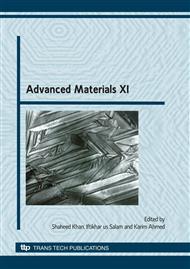[1]
Valiev RZ, Korznikov AV, Mulyukov RR. Mater Sci Eng A; 168; 46, (1993), p-141.
Google Scholar
[2]
Iwahashi Y, Wang Y, Horita J, Nemoto M, Langdon TG. Acta meter, 45, (1997), p-4733.
Google Scholar
[3]
Iwahashi Y, Wang Y, Horita J, Nemoto M, Langdon TG. Acta meter, 46, (1998), p-3317.
Google Scholar
[4]
Shin DH, Kim I, Kim J, Park K. Acta mater, 49, (2001), p-1285.
Google Scholar
[5]
Huang Jy, Zhu YT, Jiang H, Lowe TC. Acta mater, 49, (2001), p-1497.
Google Scholar
[6]
Horita Z, smith DJ, Nemoto M, Valiev Z, Langdon TG. J Mater Res, 13, (1998), p-446.
Google Scholar
[7]
Ghosh AK, Huag W. Investigation and applications of severe plastic deformation. NATO Science series, Series 3, High technology Boston, 80, (2000), p-29.
Google Scholar
[8]
Chen W, Fergusen D, Fergusen H. Ultra-fine grain materials. Warrendale, PA, TMS, (2000), pp-23-25.
Google Scholar
[9]
Enrique Lavernia, Incremental Nanotechnology shapes high-strength aluminum, Advanced Materials & Processes, December (2004), pp-11.
Google Scholar
[10]
Lu K, Lu J. J Mater Sci Tech. 15, (1999), p-193.
Google Scholar
[11]
Tao NR, Sui ML,. Nanostru Mater, 11, (1999), p- 433.
Google Scholar
[12]
Liu G, Lu J, Lu K. Mater Sci Eng. A, 286 , (2000), p-91.
Google Scholar
[13]
X Wu, N Yao, Y Hong, B Xu, J Lu, K Lu. Acta Mater, 50, (2000), p-(2075).
Google Scholar
[14]
French patent FR2812284, FR 01022482 (2002).
Google Scholar
[15]
H. P. Klug and L. F Alexander, X-ray diffraction procedures for polycrystalline and amorphous materials, Wiley, New York 1974, p-659.
Google Scholar
[16]
B.D. Cullity, Elements of x-rays diffraction, 2 nd edition, (1977), pp-99.
Google Scholar
[17]
Horita Z, Smith DJ, Furukawa, Nemoto M, Valiev Z, Langdon TG Jr. Mat Res, (1996), p.1880.
Google Scholar
[18]
Huang JY, Zhu YT, Jiang H, Lowe TC, Acta Mater, 49, (2001), p-1497.
Google Scholar
[19]
Charles Lipson and N. J. Sheth, Statistical design if engineering experiments, McGraw Hills, (1984), p-33.
Google Scholar
[20]
J.C. Willams and A.F. Belov, Titanium and Titanium Alloys, 1989, pp-470.
Google Scholar
[21]
A Ceylan, K Jastrzembski, SI Shah, Metall. & Mat. Trans A, 37A, July (2006) 2033-(2038).
Google Scholar
[22]
C. Colombo, M. Guagliano, L. Vergani, SID, 1 (2005) 253.
Google Scholar
[23]
V. Schulze, Modern Mechanical surface treatment, (2006) Wiley-VCH.
Google Scholar
[24]
I.F. Pariente, M. Guagliano, Surface and Coating technology, 202 (2008) 3072.
Google Scholar
[25]
K. Dai, L. Shaw, Materials Science and Engineering A, 463 (2007) 46.
Google Scholar
[26]
J. Ren, A. Shan, J. Zhang, H. Song, J. Liu, Materials Letters, 60 (2006) (2076).
Google Scholar
[27]
Y. Lin, J. Lu, L. Wang, T. Xua, Q. Xue, Acta Materialia, 54 (2006) 5599.
Google Scholar


